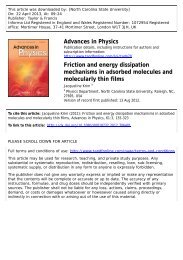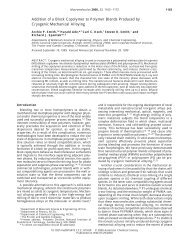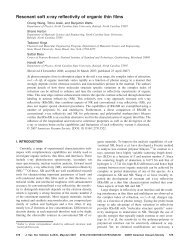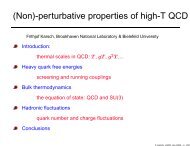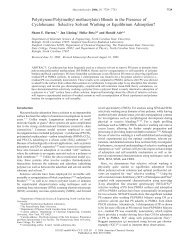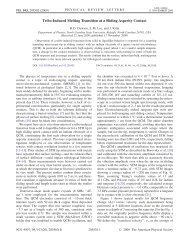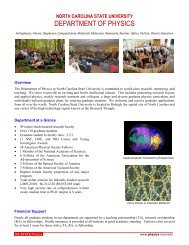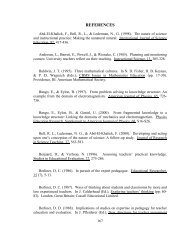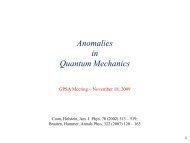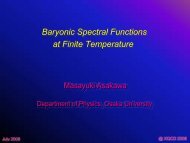Observation of Shock Waves in a Strongly Interacting ... - Physics
Observation of Shock Waves in a Strongly Interacting ... - Physics
Observation of Shock Waves in a Strongly Interacting ... - Physics
You also want an ePaper? Increase the reach of your titles
YUMPU automatically turns print PDFs into web optimized ePapers that Google loves.
PRL 106, 150401 (2011) PHYSICAL REVIEW LETTERSweek end<strong>in</strong>g15 APRIL 2011FIG. 1 (color onl<strong>in</strong>e). Collision between two strongly <strong>in</strong>teract<strong>in</strong>g Fermi gas clouds <strong>in</strong> a cigar-shaped optical trap. The clouds are<strong>in</strong>itially separated by a repulsive 532 nm optical beam. After the 532 nm beam is ext<strong>in</strong>guished (0 ms), the clouds approach each other.False color absorption images show the spatial pr<strong>of</strong>iles versus time. Initially, a sharp rise <strong>in</strong> density occurs <strong>in</strong> the center <strong>of</strong> the collisionzone. At later times the region <strong>of</strong> high density evolves from a ‘‘peaklike’’ shape <strong>in</strong>to a ‘‘boxlike’’ shape as the shock front propagatesoutward. The well def<strong>in</strong>ed edges <strong>of</strong> the central zone <strong>in</strong> the last four images provide evidence <strong>of</strong> shock wave formation <strong>in</strong> the strongly<strong>in</strong>teract<strong>in</strong>g Fermi gas.fronts. Numerical model<strong>in</strong>g <strong>of</strong> the hydrodynamic theoryfor one-dimensional motion is used to predict the evolution<strong>of</strong> the atomic density, yield<strong>in</strong>g pr<strong>of</strong>iles <strong>in</strong> good agreementwith the data.For simplicity, we assume that the cloud is a strongly<strong>in</strong>teract<strong>in</strong>g Fermi gas at zero temperature; i.e., we modelthe cloud as a s<strong>in</strong>gle fluid, consistent with our measurements<strong>of</strong> the sound velocity [20]. In this case, the localchemical potential has the universal form ðn 3D Þ¼ð1 þÞ F ðn 3D Þ, where F ðn 3D Þ¼ @22m ð32 n 3D Þ 2=3 is the idealgas local Fermi energy correspond<strong>in</strong>g to the threedimensionaldensity n 3D . Here, ¼ 0:61 is a universalscale factor [2,21,22].Neglect<strong>in</strong>g viscous forces, the dynamics for the densityn 3D ðr;tÞ and the velocity field vðr;tÞ are described by thecont<strong>in</strong>uity equationand the Euler equation@ t n 3D þrðn 3D vÞ¼0 (1)m@ t v þr½ðn 3D ÞþU trap ðr; zÞþ 1 2 mv2 Š¼0; (2)where we assume irrotational flow. Here U trap ðrÞ ¼12 m!2 ? r2 þ 1 2 m!2 zz 2 is the conf<strong>in</strong><strong>in</strong>g harmonic potential<strong>of</strong> the cigar-shaped trap.To determ<strong>in</strong>e the <strong>in</strong>itial density pr<strong>of</strong>ile for the separatedclouds, we consider the equilibrium 3D density <strong>of</strong> theFermi gas <strong>in</strong> the trap, <strong>in</strong>clud<strong>in</strong>g a knife-shaped repulsivepotential V rep ðzÞ. A blue-detuned laser beam is shaped by acyl<strong>in</strong>drical lens telescope; i.e., the spot size is small comparedto the long dimension <strong>of</strong> the cigar-shaped cloud andlarge compared to the transverse dimension. Therefore, therepulsive potential varies only <strong>in</strong> the z (axial) direction:V rep ðzÞ ¼V 0 exp½ ðz z 0 Þ 2 = 2 zŠ. We measure the width z ¼ 21:2 m. The <strong>of</strong>fset z 0 ¼ 5 m <strong>of</strong> the focus fromthe center <strong>in</strong> the long direction <strong>of</strong> the optical trap isdeterm<strong>in</strong>ed by a fit to the first density pr<strong>of</strong>ile at 0 ms.Us<strong>in</strong>g the beam <strong>in</strong>tensity and the ground state static polarizability<strong>of</strong> 6 Li at 532 nm, we f<strong>in</strong>d V 0 ¼ 12:7 K. The<strong>in</strong>itial density pr<strong>of</strong>ile is thenn 3D ðr; zÞ ¼~n 1r 2R 2 ?z 2R 2 zV rep ðzÞ G 3=2;(3)where ~n ¼½ð2m G =@ 2 Þ=ð1 þ ÞŠ 3=2 =ð3 2 Þ. In Eq. (3),qffiffiffiffiffiffiffiffiffiffiffiffiffiffiffiffiffiffiffiffiffiffiffiffiffiffiffiffiffiR z;? ¼ 2 G =ðm! 2 z;? Þ and G is the global chemicalpotential, which is determ<strong>in</strong>ed by normaliz<strong>in</strong>g the <strong>in</strong>tegral<strong>of</strong> the 3D density to the total number N <strong>of</strong> atoms <strong>in</strong> bothsp<strong>in</strong> states. For N ¼ 2 10 5 , we f<strong>in</strong>d G ¼ 0:53 K,R z ¼ 220 m, and R ? ¼ 14 m.We note that G =ð@! ? Þ¼27, which means that thetypical number <strong>of</strong> filled energy levels <strong>of</strong> transverse quantizationis large. Therefore, <strong>in</strong> this Letter, we use 3Dhydrodynamics [Eqs. (1) and (2)] and neglect effects <strong>of</strong>transverse quantization even though they are more pronounced<strong>in</strong> regions with lower density.We model the dynamics for the one-dimensional motion<strong>in</strong> the long direction <strong>of</strong> the cigar-shaped trap. Just after theblue-detuned beam is ext<strong>in</strong>guished, the <strong>in</strong>itial 1D densitypr<strong>of</strong>ile is determ<strong>in</strong>ed by <strong>in</strong>tegrat<strong>in</strong>g n 3D <strong>of</strong> Eq. (3) over thetransverse dimension r:n 1D ðzÞ ¼ 2 5 R2 ? ~n 1z 2R 2 zV rep ðzÞ G 5=2:(4)In the follow<strong>in</strong>g, we assume that dur<strong>in</strong>g the evolution ther dependence <strong>of</strong> Eq. (3) is preserved with the effective size<strong>of</strong> the cloud be<strong>in</strong>g a slow function <strong>of</strong> z and t. We alsoassume that the hydrodynamic velocity is along the z axis150401-2




